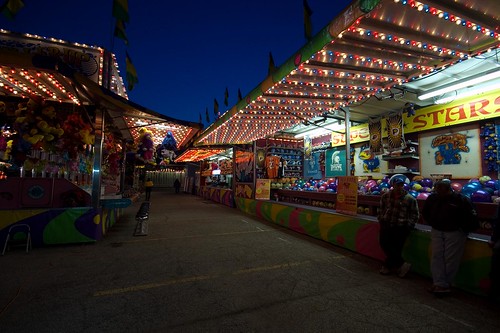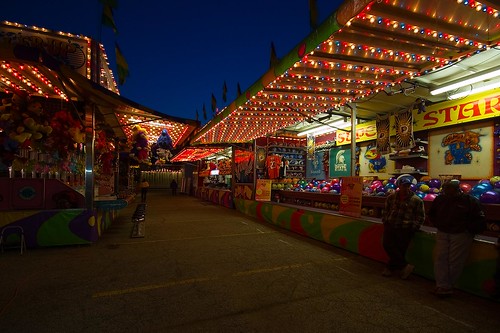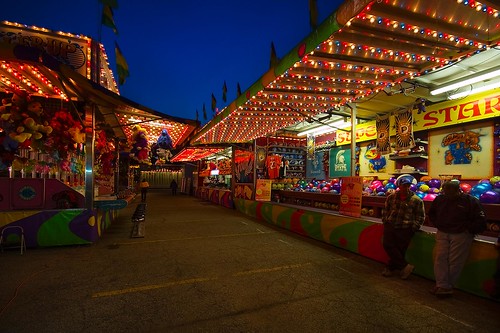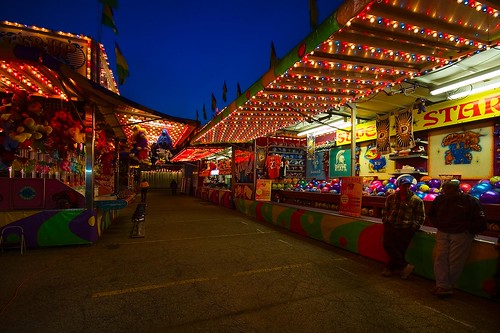Forums › Forums › Farktography General Chat › Farktography Pub and Grill › about unfairness, imho, in the rules
- This topic has 91 replies, 17 voices, and was last updated 15 years, 8 months ago by
FutherMucker.
-
AuthorPosts
-
July 24, 2008 at 9:07 pm #17944
DeaconBlues
Participantelsinore- not really. You don’t dodge and burn a negative, at least not without potassium ferricyanide, which would be the same thing as photoshopping someone out of a picture. You only dodge and burn prints. In the darkroom, dodging and burning is accomplished by using different amounts of light on your printing paper (through the negative) in different places on the print, to make some parts darker or lighter.
I have mentioned both scanning finished darkroom prints as well as scanning negatives and doing post on a computer. Both methods generally use the same basic manipulations, just performed differently (obviously).
As far as darkroom dos and donts go, here is an “alpha test” list”
Allowed:
Dodging and Burning in
spot toning of dust and scratches only
toning (selenium, sepia, etc) or tinting (blue, red, tea, etc) only if applied to entire imageDisallowed:
using multiple negatives
removing compositional elements from negatives or prints with chemicals like potassium ferricyanide or farmer’s reducerQuestionable (things i am just not sure about)
cross processing color negatives
solarizations
moving the enlarger head during print exposure
torn borders on prints
infrared film
this list is by no means exhaustive, it just represents the things that popped in to my head on the spot. It is basically a first attempt at creating a list of practices that are and are not used in making your average standard photographic print as opposed to a graphic design/printmaking print that uses photographic elements. This list is also just for black and white darkroom techniques. I have never done color darkroom work, because it ceased being anywhere near cost effective some time ago, and the results arent generally better enough in my opinion.I know that for people who never shot much or any film, and/or never did any darkroom work, the extra steps involved in film photography instead of digital can seem a bit weird when you are used to basically going straight from taking the shot to making the print, but having that negative to deal with in the middle when using film definitely shifts things a bit.
July 24, 2008 at 9:10 pm #17945soosh
Participantcross processing color negatives ….infrared film
These are allowed.
July 24, 2008 at 9:20 pm #17946SilverStag
ParticipantStay tuned- I’m working on a series of images to illustrate some points, I hope.
July 25, 2008 at 1:23 am #17947Killerclaw
ParticipantI think the fact that we all have different limitations and helpful things is what makes Farktography interesting, any art for that matter. Imagine if every painter used the same brush and paint set.
Soosh has his Alaskan stuff, U-man has kids, Stapler has staplers, I have that creepy doll, etc. Almost all of us shoot with different equiptment and composistion, but almost all the serious Farktographers have won at least once.
July 25, 2008 at 3:31 am #17948linguine
ParticipantWhile all these points are valid, if we’re really worried about fairness and balance then we’re just going to have to go ahead and ban umans kids, cause theyre just not fair to the rest of us.
July 25, 2008 at 5:54 am #17949SilverStag
ParticipantSorry it took me so long- I had to actually go to work for a bit.
I thought it might help if I took an image through a series of steps, and delineate some methods, and have a discussion about the rules with respect to Photoshop. Here’s the image straight from the camera, nothing whatsoever done to it:

I went back to the camera raw file and turned up the color temperature to warm the image a little, and then used Lens correction in Photoshop to tweak things a little and take some of the wideangle-induced ‘lean’ out of the booth to the left:

I changed the image to LAB mode and sharpened it using the lightness channel only, then added an A-and-B channel only curves adjustment layer to boost the color about 14%:

Here’s where it gets tricky- I made a duplicate layer of the background and changed the blending to screen mode, which has the effect of lightening the whole image. I then added a black layer mask (essentially hiding the entire new layer) and painted (dodged, if you will) with a soft white brush the areas I wanted to lighten. This method does not wash out the colors like using the dodge tool in Photoshop, plus it has the advantage of being easily reversible if you screw up, plus you can lower the opacity of the layer to vary the effect:

After flattening the previous image, I decided I’d like a tad more contrast. I made a duplicate background layer, and set the blend mode to soft light, then reduced the opacity to about 15%. This lets you add a little contrast without messing with the highlights:

SO where does this workflow cross the line, if in fact it does, in your opinion? For Farktography, I usually stop at the LAB sharpening & color step. I picked this photo simply because I thought it would be a good one to illustrate the various concepts. Fire away!
July 25, 2008 at 6:54 am #17950DeaconBlues
Participant“Imagine if every painter used the same brush and paint set.”
This.
July 25, 2008 at 11:56 am #17951Elsinore
KeymasterSO where does this workflow cross the line, if in fact it does, in your opinion? For Farktography, I usually stop at the LAB sharpening & color step. I picked this photo simply because I thought it would be a good one to illustrate the various concepts. Fire away!
Under the current rules, you cross the line when you blend layers in anything but normal mode.
As to where the line should be…I don’t know. That just seems like a *lot* of post processing, and as schnee mentioned, part of the justification for the rules was to even the playing field a bit between people who do and don’t have access (or money) for that level of photo editing.
July 25, 2008 at 4:49 pm #17952soosh
Participantor money
gimp is free and will do most anything that photoshop will do. If someone is really interested in learning the steps needed to post-process, the internet is full of tutorials, and I think most people here would be willing to tell how they’ve accomplished something. I’m completely self-taught when it comes to photography, and some of my favorite photos were done with Holgas or $125 tlr cameras I bought on ebay. Yes, I’ve spent a lot of money on lenses as well, but I don’t use some of my most expensive glass for many of these contests.
Post-processing is a fact of life for digital photography, and for me, as I scan slides or negatives, it’s part of film photography as well. Point & shoot cameras do a lot of post-processing in the camera and the user has little control over what level of sharpness, saturation, & exposure compensation is done in the camera. a dSLR strips all that away, if you want it to, and lets you control the process more exactly in post. Trying to minimize the level of post-processing, to me, is like telling me that to keep the playing field level, I can’t shoot in Manual mode or use a wide-open aperture or a remote release cable because someone with a digicam can’t do those things. Trying to level the playing field isn’t going to work until we send out official Farktography Cameras and don’t let anybody shoot with anything else.
All of that said, no post-processing or expensive camera is the key to winning. The best photos are going to be taken by the best photographers, regardless of what gear they use. I think creativity, composition, and a well-thought-out plan of execution will win out time and time again, and that can be done with any level of camera.
July 25, 2008 at 4:53 pm #17953soosh
ParticipantThat just seems like a *lot* of post processing
agreed. But I don’t think it should disqualify the image. I’ve never done that much processing to my images. I haven’t yet figured out how to use layer masks for adjusting exposure, ever converted anything to LAB, or corrected for lens distortion. But I don’t have any problem competing with somebody going to all that trouble. I go to a lot of trouble setting up some of my shots. I’ve waited over a year for the right light in some cases. I think we should be competing on the basis of the finished product, not how we got there.
And quite frankly, looking at Silver Stag’s finished photo, I would have had no idea he’d done all that work. He’s done it so well that it looks to me like the photo came out of the camera that way. We’re all on our honor here, but I think that so long as we’re not adding or removing elements to the photo that weren’t there, the photo should be allowed.
July 25, 2008 at 6:55 pm #17954Analogy
ParticipantI’m of the school of thought that anything you could get away with as a newspaper photographer should be allowed… As long as the final result is still fundamentally the same picture that you originally took, I don’t see why you shouldn’t be allowed to do some basic spot treatment to make things a little prettier.
July 25, 2008 at 9:20 pm #17955DeaconBlues
ParticipantSO where does this workflow cross the line, if in fact it does, in your opinion? For Farktography, I usually stop at the LAB sharpening & color step. I picked this photo simply because I thought it would be a good one to illustrate the various concepts. Fire away!
Under the current rules, you cross the line when you blend layers in anything but normal mode.
As to where the line should be…I don’t know. That just seems like a *lot* of post processing, and as schnee mentioned, part of the justification for the rules was to even the playing field a bit between people who do and don’t have access (or money) for that level of photo editing.
I concur with soosh, and also wish to add a couple of points. GIMP is available for windows (and perhaps mac as well) these days. Also, in the not free but not 92834756 bucks segment, you have programs like lightzone. Also, you can always find a college student, buy em a case of beer, and get em to score you an uber cheap copy of photoshop cs3, as it is heavily discounted for college students. There are a number of other programs out there, like aperture and lightroom, that i am not familiar with, which don’t carry the 1000 dollar plus price tag of adobe creative suite cs3.
SilverStag- great work on that carnival shot. You took an image that needed a little help, and made it in to a much better image. It is still fundamentally the same, just a bit brightened up. Excellent shot.
July 25, 2008 at 9:51 pm #17956Elsinore
KeymasterI see what you guys are saying, and they’re all good points. I just hope we don’t lose sight of the fact that Farktography has always been about accessibility to everyone, from the snapshooter to the prosumer to the pro. And yeah, the composition or the funny or the boobies will probably always mean more than the fact that you lightened the sky. I just don’t know. I fear large scale change. Somebody hold me… 😆
July 25, 2008 at 10:01 pm #17957soosh
ParticipantOne thing I would like to say is if we ever let partially desaturated photos such as
http://www.flickr.com/photos/special/732517/
be allowed, I’m out of here*.
*with the exception of a contest dedicated to such abortions. then I can simply skip that week.
July 25, 2008 at 10:07 pm #17958DeaconBlues
ParticipantI see what you guys are saying, and they’re all good points. I just hope we don’t lose sight of the fact that Farktography has always been about accessibility to everyone, from the snapshooter to the prosumer to the pro. And yeah, the composition or the funny or the boobies will probably always mean more than the fact that you lightened the sky. I just don’t know. I fear large scale change. Somebody hold me… 😆
I think a bit more flexibility in the rules would make it more accessible to everyone. IMHO, more flexibility yields more diversity, and more diversity equals the environment for creating a bigger tent which can bring more photographers in to the mix. Look, for instance, at the number of one hit wonders on the FSM page, and think about the various potential farktographers that have, for one reason or another, participated briefly and then stopped. Perhaps these proposed tweaks could serve to make things more accessible to a broader swath of the photographic population.
/ I would hold you, but Zeke would splat me. Anyone who can pull a 747 is a scary mofo in my book 🙂
-
AuthorPosts
- The topic ‘about unfairness, imho, in the rules’ is closed to new replies.